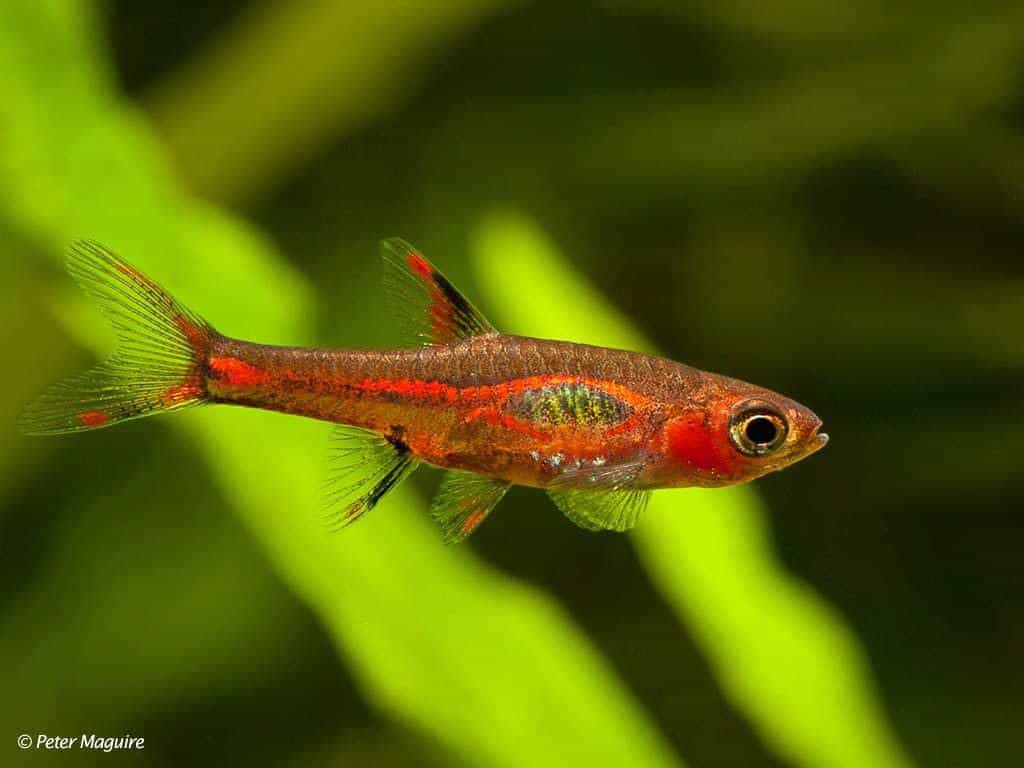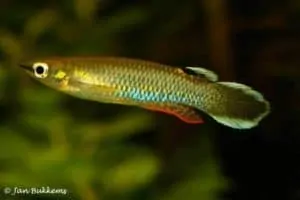Boraras brigittae – Chili Rasbora – Mosquito Rasbora
Boraras brigittae was officially described by Vogt in 1978. They belong to the family Danionidae or the Danios. This family is further divided into subfamilies. Boraras brigittae belongs to the subfamily Rasborinae.
The genus name Boraras is an anagram of Rasbora, a reference to the inverse ratio between the fin rays of the ventral and caudal fins of these species. The species name brigittae is in honor of Dieter Vogt’s wife, Brigitte. Two of the most common names are Chili Rasbora and Mosquito Rasbora.
The genus Boraras has only six species. They are all small in size. Boraras brigittae is most similar to Boraras urophthalmoides. Boraras urophthalmoides stay even smaller and are less brightly colored. It is best to tell them apart by looking at the stripe on the flank and the dot on the caudal peduncle. The stripe on Boraras brigittae is somewhat messy and the dot on the caudal peduncle is absent or much less obvious than that of Boraras urophthalmoides.
Description of the Chili Rasbora
With a total maximum length of 3 centimeters, the Chili Rasbora remains very small. The fish are beautiful red in color.
Across the body is a black transverse band, and the caudal fin is transparent with red tips on the lower and upper fin radius. These red points are also visible on the tips of the dorsal and anal fins. The fins have a black stripe on the front fin radius between this red tip and the body.
The difference between the males and females can be seen in the slightly rounder shape of the females, they are also slightly larger than the males. The Chili Rasbora males are more brightly colored than the females.
Lifespan
Despite the small size of these fish, they can live to be quite old. With good care and the right conditions, they can live up to four to eight years old.

Biotope
Boraras brigittae can only be found in Indonesia, they occur in southwestern Borneo. There they inhabit the black water of the old peat swamps. This water gets a tea color from the tannins that leak from the organic material in and on the bottom. Because the soil consists of peat, the water is very soft and acidic.
Diet
In the wild, Boraras brigittae prey on small prey such as insects, larvae, and worms. In the aquarium, it is not a picky eater. In the aquarium, it is not a picky eater. As long as the food fits in its mouth, it will be eaten. Small dry food, frozen food, and live food are all on the menu. Regularly fresh brine shrimp is a good choice if you want to keep the color of Chili Rasbora optimal. Other live foods such as daphnia are eaten readily.
The aquarium
These fish make few demands on the layout of the aquarium. It doesn’t have to be a big aquarium, of course. Set up the aquarium with a dark bottom and some plants. It is also advisable to add some floating plants to make the colour of the fish stand out better.
Boraras brigittae is a somewhat shy fish. They tend to hide in a brightly lit or crowded aquarium. It is, therefore, better to keep them in a less brightly lit aquarium. Filtering over peat or alder plugs makes the water a bit darker and also makes the colors stand out a bit better. This also ensures that the water becomes softer and more acidic.
To feel safe, the Chili Rasbora needs congeners. In the wild, they live in schools. Keep them in a school from eight copies, but preferably much more. They are then more inclined to come forward and show natural behavior.
Water parameters
The temperature of the water may be between 20 and 28 degrees Celsius, the pH between 4.0 and 7.0. They don’t like a lot of current. Due to their small size, they lose too much energy swimming. Also, take the filtration into account and do this in such a way that no strong current is created.
Biotope aquarium
A biotope-correct aquarium can be set up with some (filter) sand on the bottom. Decorate the aquarium further with some branches and wood. Create darker parts in the water with the wood. In the wild, they mainly live in blackwater with few plants but with overhanging branches.
Place some dried leaves on the bottom. These leaves color the water a bit darker. A second advantage of the leaves is the creation of infusoria. Small living animals live among the leaves and form a food source for the Chili Rasbora. You can replace the leaves after a few weeks or just leave them until they have completely decomposed.
Plants that can handle these conditions are Java moss, Java fern or Cryptocoryne species.
Suitable tankmates
It is best to keep these mini fish in a special aquarium. Larger fish quickly see the Chili Rasbora as food. If you really want to keep them with other fish, choose small fish from four to five centimeters in length, or choose shrimps that remain small.
Breeding Boraras brigittae – Chili Rasbora
The Chili Rasbora is an egg scatterer. The eggs are continuously deposited between the plants. They lay a few eggs every day.
In an aquarium where the parents are still with, the parents and other fish will eat most of the eggs. The newly hatched young fish are also not safe. Only in a densely planted aquarium will an occasional egg escape the attention of the fish, hatch, and grow up.
For breeding and raising Boraras brigittae in larger numbers, you need at least one extra aquarium.
Spawning Tank and Conditioning
Set up a separate breeding tank of about 10 to 15 liters. Place a grid on the bottom that the fish cannot get through but that is just big enough for the eggs. If you cannot find this, a piece of artificial grass is also a great alternative.
The aquarium needs little or no lighting. For filtering, you can use a small sponge filter. The advantage of this is that the young fish use this to snack on food particles.
Use a large patch of Java Moss to create some hiding places. This should fill a large part of the aquarium. The water should be soft and a little more acidic. A pH down to 6.5 or even lower works best. They also make some demands on the temperature for the best spawning result. Keep the temperature a bit higher, around 27 to 28 degrees Celsius.
In the meantime, feed two or three pairs of Chili Rasbora with good quality food. This puts the parents in the right mood to lay eggs.
The spawn
As soon as the breeding aquarium is well established and the parents are well-fed, it is time to move them. If the water values deviate considerably, you have to take the time to let them get used to the water. For example, use the drip method so that they do not get too much stress.
The next morning the spawning begins. Every day they lay a few eggs among the Java moss. The eggs hatch after a day or two. The young Boraras brigittae then live on their egg yolk sac for another 24 hours. After this, they go free swimming and it is time to remove the parents. The parents do not consciously hunt the young Chili Rasbora, but they do eat the eggs.
Raising the young Boraras brigittae
The newly hatched Boraras brigittae are very very small. They only eat the smallest food such as infusoria (Paramecium). As the young fish grow, you can switch to nematodes, micro worms, and brine shrimp. You can often grow this live food for young fish yourself.
After a few days, all the eggs have hatched and they are swimming around freely. The young fish are still very sensitive to changes in water values. Therefore, only change a small amount of water after two weeks to prevent fluctuations.
Video
Authors
Rick
John de Lange
Copyright images
F. Ingemann Hansen – Akvariefotografen.com
Peter Maguire
References
Fishbase
Seriouslyfish
Resolving Cypriniformes relationships using an anchored enrichment approach
Disentangling the taxonomy of the subfamily Rasborinae (Cypriniformes, Danionidae) in Sundaland using DNA barcodes















Reviews
There are no reviews yet.